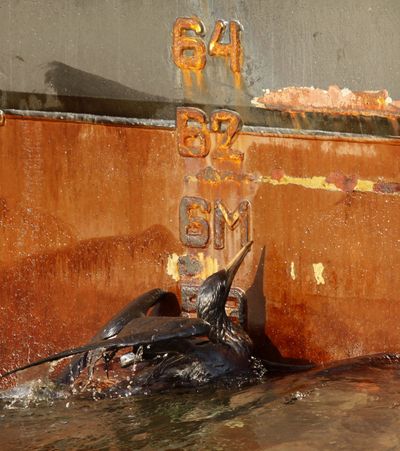After containment failure, BP considers other options

ON THE GULF OF MEXICO – A day after icy slush clogged the massive box they hoped would contain an out-of-control oil gusher in the Gulf of Mexico, BP officials on Sunday said they may try again – this time with a smaller box.
They also were considering several other options to stop the daily rush of at least 200,000 gallons of crude, which began washing up on beaches in thick blobs over the weekend.
With crippled equipment littering the ocean floor, oil company engineers scrambled to devise a fresh method to cap the ruptured well. Their previous best hope for containing the leak quickly, a four-story containment box, became encrusted with deep-sea crystals Saturday and had to be cast aside.
Among the plans under consideration:
•Deploying a new, smaller containment box in the hope that it would be less likely to get clogged. Officials said the new box could be in place by midweek.
•Cutting the riser pipe, which extends from the mile-deep well, undersea and using larger piping to bring the gushing oil to a drill ship on the surface, a tactic considered difficult and less desirable because it will increase the flow of oil.
•Shooting mud and concrete directly into the well’s blowout preventer, a device that was supposed to shut off the flow of oil after the deadly April 20 oil rig explosion, but failed. The technique, known as a “top kill,” is supposed to plug up the well and would take two to three weeks.
•Try again using the containment box that failed to work Saturday after finding a way to keep the crystals from building up.
The engineers appear to be “trying anything people can think of” to stop the leak, said Ed Overton, a LSU professor of environmental studies.
“Hopefully these are low-risk type of operations,” he said. “We don’t want to do anything to make it flow more.”
An estimated 3.5 million gallons of oil have spilled since the explosion. At that pace, the spill would surpass the 11 million gallons spilled in the Exxon Valdez disaster by next month. BP is drilling a relief well that is considered a permanent fix, but that will take several weeks to complete.
There was a renewed sense of urgency as dime- to golfball-size balls of tar washed up Saturday on Dauphin Island, three miles off the Alabama mainland at the mouth of Mobile Bay and much farther east than the thin, rainbow sheens that have arrived sporadically in the Louisiana marshes. Until Saturday none of the thick sludge – those indelible images from the Valdez and other spills – had reached shore.